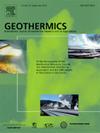Characteristics and mechanism of the calcite scaling and plugging in DZK02 geothermal well, western Sichuan, China
IF 3.9
2区 工程技术
Q3 ENERGY & FUELS
引用次数: 0
Abstract
The issue of calcite scaling and plugging in geothermal wellbores and pipelines significantly hinders the development and utilization of geothermal energy. During an 8-day blowout test of the DZK02 geothermal well in Kangding, western Sichuan, China, it was observed that the scaling thickness reached 1 to 3 cm in the surface pipeline. This phenomenon involves complex processes such as multiphase flow, reactive solute transport, and mineral particle migration and deposition. In this study, we have incorporated the functionality of multiphase flow in wellbores into the general-purpose reactive transport program TOUGHREACT while integrating crystal scaling and particle scaling theories. We applied this program to analyze DZK02 geothermal well with a focus on investigating the mechanisms, characteristics, and influencing factors associated with calcite scaling and plugging. With limited information available on the wellhead conditions, we estimated bottom conditions and reproduced the entire blowout process. Our findings indicate that CO2 partial pressure at the bottom ranges from 15 to 25 bar, which positively correlate with flash and scaling occurring at the depth. Most of the scale accumulates as particles within the surface pipeline because of the diameter change. This study presents a robust numerical simulation method for analyzing calcite scaling issues within geothermal systems, while providing valuable insights for future utilization strategies concerning DZK02 well.
川西DZK02地热井方解石结垢堵塞特征及机理
地热井和地热管道中方解石结垢和堵塞问题严重阻碍了地热能的开发利用。在四川康定DZK02地热井8天的井喷试验中,观察到地面管道结垢厚度达到1 ~ 3 cm。这一现象涉及复杂的过程,如多相流、反应性溶质输运和矿物颗粒的迁移和沉积。在这项研究中,我们将井筒中多相流的功能整合到通用反应输运程序TOUGHREACT中,同时整合了晶体结垢和颗粒结垢理论。应用该程序对DZK02地热井进行了分析,重点探讨了方解石结垢堵塞的机理、特征及影响因素。在井口条件信息有限的情况下,我们估计了井底条件,并重现了整个井喷过程。我们的研究结果表明,底部的CO2分压范围为15 ~ 25bar,这与深度发生的闪蒸和结垢呈正相关。由于管道直径的变化,大部分水垢以颗粒形式积聚在管道表面。该研究提出了一种强大的数值模拟方法来分析地热系统中方解石结垢问题,同时为DZK02井的未来利用策略提供了有价值的见解。
本文章由计算机程序翻译,如有差异,请以英文原文为准。
求助全文
约1分钟内获得全文
求助全文
来源期刊

Geothermics
工程技术-地球科学综合
CiteScore
7.70
自引率
15.40%
发文量
237
审稿时长
4.5 months
期刊介绍:
Geothermics is an international journal devoted to the research and development of geothermal energy. The International Board of Editors of Geothermics, which comprises specialists in the various aspects of geothermal resources, exploration and development, guarantees the balanced, comprehensive view of scientific and technological developments in this promising energy field.
It promulgates the state of the art and science of geothermal energy, its exploration and exploitation through a regular exchange of information from all parts of the world. The journal publishes articles dealing with the theory, exploration techniques and all aspects of the utilization of geothermal resources. Geothermics serves as the scientific house, or exchange medium, through which the growing community of geothermal specialists can provide and receive information.
 求助内容:
求助内容: 应助结果提醒方式:
应助结果提醒方式:


